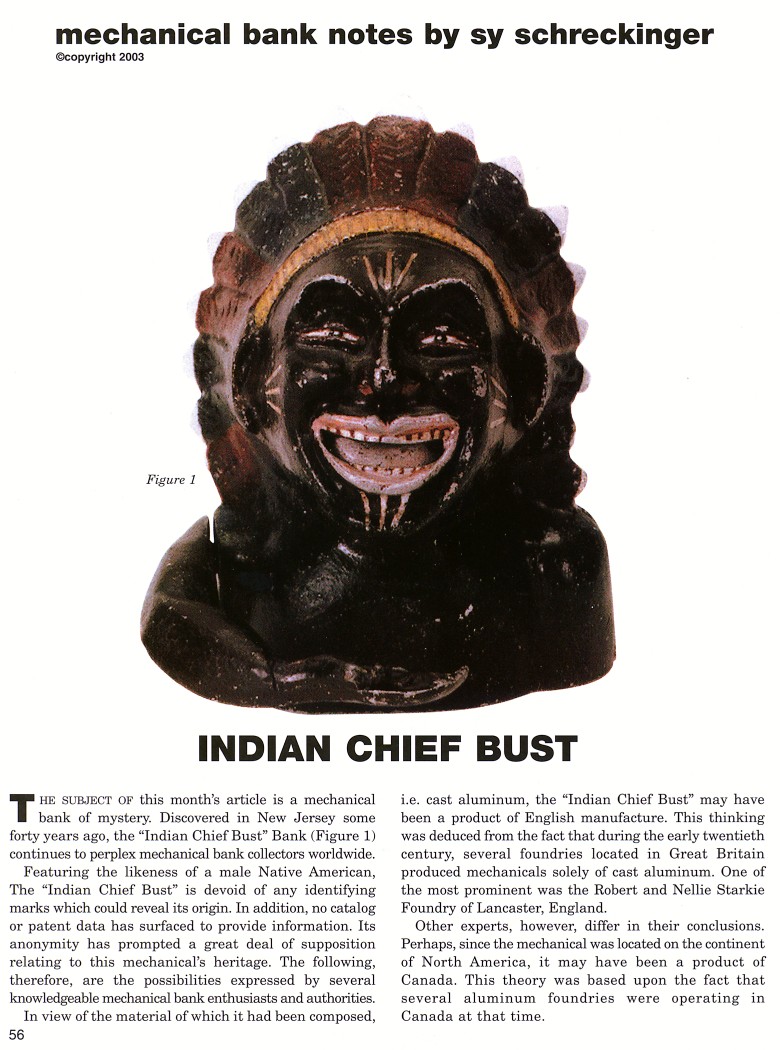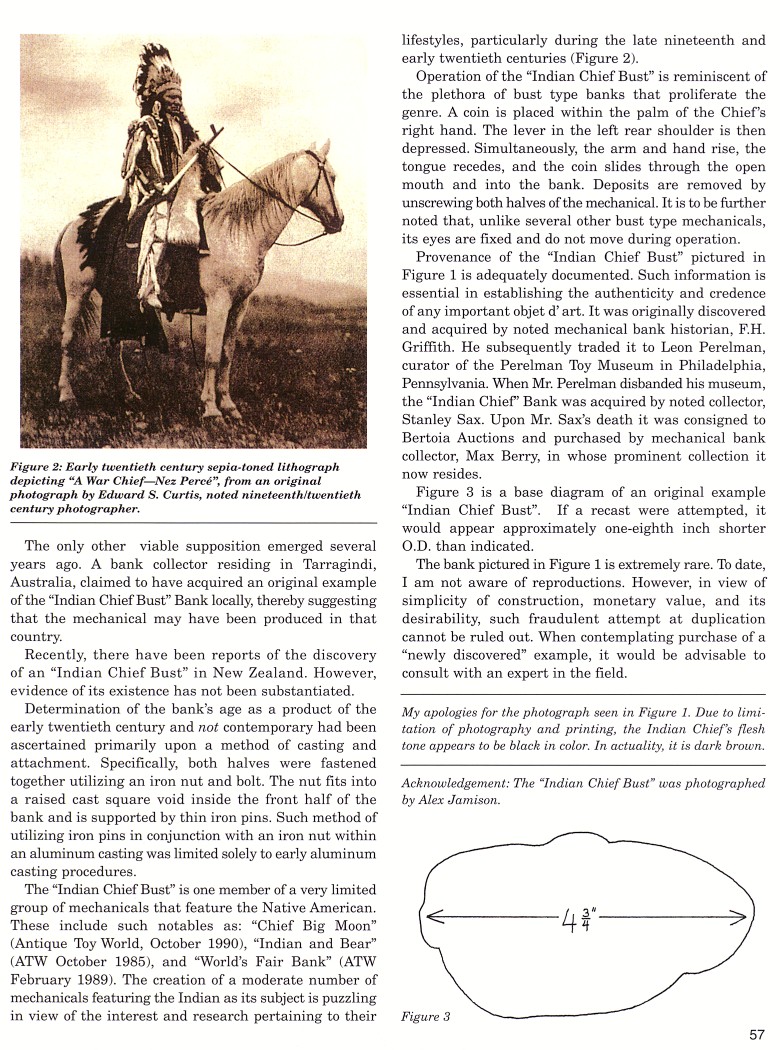|
Indian Chief Bank
by Sy Schreckinger – ANTIQUE TOY WORLD Magazine – August, 2003
The subject of this month's article is a
mechanical bank of mystery. Discovered in New Jersey some forty years ago,
the "Indian Chief Bust" Bank (Figure 1) continues to perplex mechanical
bank collectors worldwide.
Featuring the likeness of a male Native American, The "Indian Chief
Bust" is devoid of any identifying marks which could reveal its origin. In
addition, no catalog or patent data has surfaced to provide information.
Its anonymity has prompted a great deal of supposition relating to this
mechanical's heritage. The following, therefore, are the possibilities
expressed by several knowledgeable mechanical bank enthusiasts and
authorities.
In view of the material of which it had been composed, i.e. cast
aluminum, the "Indian Chief Bust" may have been a product of English
manufacture. This thinking was deduced from the fact that during the early
twentieth century, several foundries located in Great Britain produced
mechanicals solely of cast aluminum. One of the most prominent was the
Robert and Nellie Starkie Foundry of Lancaster, England.
Other experts, however, differ in their conclusions. Perhaps, since
the mechanical was located on the continent of North America, it may have
been a product of Canada. This theory was based upon the fact that several
aluminum foundries were operating in Canada at that time.
The only other viable supposition emerged several years ago. A bank
collector residing in Tarragindi, Australia, claimed to have acquired an
original example of the "Indian Chief Bust" Bank locally, thereby
suggesting that the mechanical may have been produced in that country.
Recently, there have been reports of the discovery of an "Indian
Chief Bust" in New Zealand. However, evidence of its existence has not
been substantiated. Determination of the bank's age as a product of the
early twentieth century and not contemporary had been ascertained
primarily upon a method of casting and attachment. Specifically, both
halves were fastened together utilizing an iron nut and bolt. The nut fits
into a raised cast square void inside the front half of the bank and is
supported by thin iron pins. Such method of utilizing iron pins in
conjunction with an iron nut within an aluminum casting was limited solely
to early aluminum casting procedures.
The "Indian Chief Bust" is one member of a very limited group of
mechanicals that feature the Native American. These include such notables
as: "Chief Big Moon" (Antique Toy World,
October, 1990), "Indian and Bear"
(A.T.W. October, 1985), and "World's Fair Bank" (A.T.W.
February, 1989). The
creation of a moderate number of mechanicals featuring the Indian as its
subject is puzzling in view of the interest and research pertaining to
their lifestyles, particularly during the late nineteenth and early
twentieth centuries (Figure 2).
Operation of the "Indian Chief Bust" is reminiscent of the plethora
of bust type banks that proliferate the genre. A coin is placed within the
palm of the Chief's right hand. The lever in the left rear shoulder is
then depressed. Simultaneously, the arm and hand rise, the tongue recedes,
and the coin slides through the open mouth and into the bank. Deposits are
removed by unscrewing both halves of the mechanical. It is to be further
noted that, unlike several other bust type mechanicals, its eyes are fixed
and do not move during operation.
Provenance of the "Indian Chief Bust" pictured in Figure 1 is
adequately documented. Such information is essential in establishing the
authenticity and credence of any important objet d' art. It was originally
discovered and acquired by noted mechanical bank historian, F.H. Griffith.
He subsequently traded it to Leon Perelman, curator of the Perelman Toy
Museum in Philadelphia, Pennsylvania. When Mr. Perelman disbanded his
museum, the "Indian Chief" Bank was acquired by noted collector, Stanley
Sax. Upon Mr. Sax's death it was consigned to Bertoia Auctions and
purchased by mechanical bank collector, Max Berry, in whose prominent
collection it now resides.
Figure 3 is a base diagram of an original example "Indian Chief
Bust". If a recast were attempted, it would appear approximately
one-eighth inch shorter O.D. than indicated.
The bank pictured in Figure 1 is extremely rare. To date, I am not
aware of reproductions. However, in view of simplicity of construction,
monetary value, and its desirability, such fraudulent attempt at
duplication cannot be ruled out. When contemplating purchase of a "newly
discovered" example, it would be advisable to consult with an expert in
the field.
My apologies for the photograph seen in Figure 1. Due to limitation
of photography and printing, the Indian Chief's flesh tone appears to be
black in color. In actuality, it is dark brown.
Acknowledgement: The "Indian Chief Bust" was photographed by Alex
Jamison.
|


